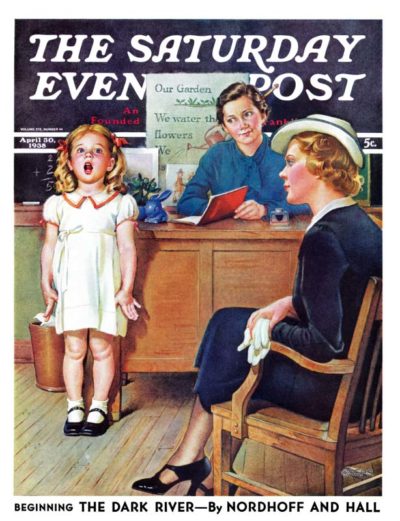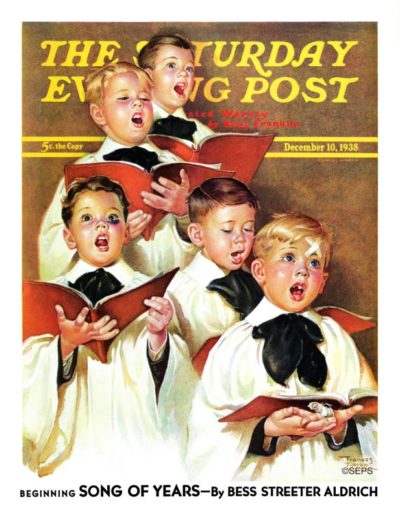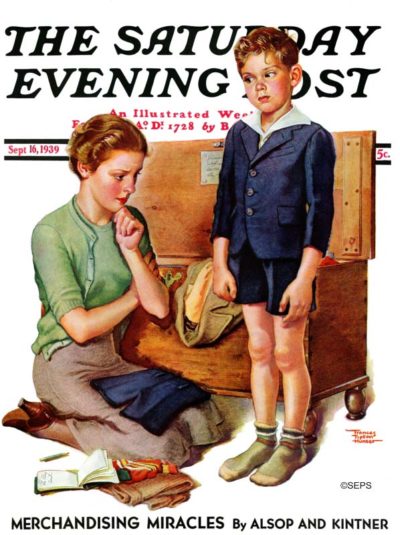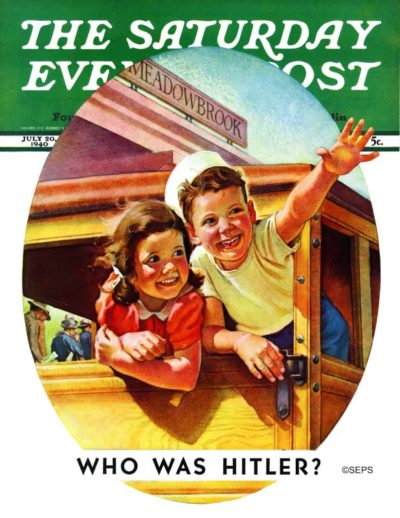One of Frances Tipton Hunter’s earliest memories is of herself at age 3 drawing over her grandmother’s wallpaper. Losing her mother at the age of 6, Hunter and her brother moved to Williamsport, Pennsylvania, to live with an aunt and uncle. Education was an important part of Hunter’s artistic life; she attended the Philadelphia Museum School of Industrial Arts and the Philadelphia Academy of the Fine Arts, graduating from both institutes with honors. While still a student, Hunter began to illustrate children’s fashions for department stores. The success allowed Hunter to move to New York where she continued her illustration career.
Along with her work in the Post, Hunter illustrated fashion catalogs and advertisements for children’s clothing as well as illustrating for other publications including Collier’s, Good Housekeeping, and Ladies’ Home Journal. Her subjects were most often children with cherubic features. Hunter tried to capture the happiness and innocence of youth, inspired by memories with her mother. Hunter’s work made her one of the most well-known artists of the 20th century, with paper dolls and picture books of her work being sold. With a style similar to Norman Rockwell, Hunter captured the ideal American childhood. Along with her18 covers for The Saturday Evening Post, Hunter’s drawings were nationally recognized from the 1920s to the 1950s.
In her first Post cover, Hunter put her best foot forward with this adorable couple. Hunter never had children of her own, so used her work to create adorable flashes of childhood innocence.

Frances Tipton Hunter
June 6, 1936
Post editors came up with this cover idea of a boy not wanting new long-johns, and Hunter loved it. For inspiration, Hunter waited in a department store waiting for the right mother/son pair to sketch.

Frances Tipton Hunter
February 27, 1937
This young man wasted no time taking over his sister’s playhouse. With the dolls strewn across the ground, a Keep Out sign on the door, and his toy gun loaded, he will defend his new headquarters.

Frances Tipton Hunter
October 9, 1937
This little girl is trying to impress her mother; her blonde curls match the woman’s in the chair. But her hands give away her nerves as they flap by her sides.

Frances Tipton Hunter
April 30, 1938
A quick glance may give the impression of an angelic children’s choir. Closer inspection will reveal a black eye and a bandaged head and fingers on the two boys up front.

Frances Tipton Hunter
December 10, 1938
Most kids grow about 2 inches each year, so this mother likely has a lot of work ahead of her.

Frances Tipton Hunter
September 16, 1939
In this cover, Hunter depicted adolescence. You can see the math problems the young man should be paying attention to floating in the background.

Frances Tipton Hunter
May 25, 1940
While the adults behind these kids concern themselves with more important matters, these kids don’t care. Their mission is simply to enjoy a ride on the trolley.

Frances Tipton Hunter
July 20, 1940
Become a Saturday Evening Post member and enjoy unlimited access. Subscribe now




Comments
They are not in the public domain, but if you’re interested in getting permission for any of them, please let us know and we can put you in touch with the correct person.
Are any of the illustrations on this page in the public domain?